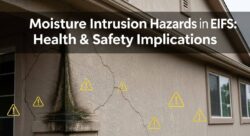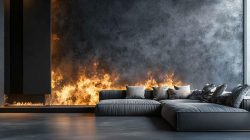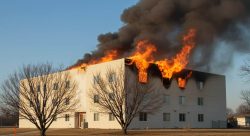Expert Tips to Showcase Seasonal Décor Without Damaging Your EIFS Exterior
As someone who’s been working with EIFS (Exterior Insulation and Finish Systems) for over 22 years here in central Indiana, I’ve seen my fair share of well-intentioned homeowners accidentally damage their beautiful synthetic stucco while trying to hang outdoor lights or install decorative fixtures. Just last month, I had to repair a gorgeous EIFS home in Carmel where the homeowner had driven dozens of nails directly through the acrylic finish to hang string lights for a backyard party. What should have been a simple decoration project turned into a $3,200 repair job.
Whether you’re planning summer entertaining lighting, seasonal decorations, or year-round outdoor fixtures, your home deserves to look beautiful. But here’s the thing – EIFS requires special care when it comes to decorating. One wrong move with a nail or screw, and you could be looking at expensive repairs that affect your home’s moisture management and energy efficiency. The good news? With the right techniques and materials, you can create stunning displays that enhance your home’s curb appeal without compromising the structural integrity of your cladding system.
Key Takeaways for Safe EIFS Decoration
- Never use nails, screws, or invasive fasteners directly into EIFS surfaces
- Adhesive hooks and removable clips are your best friends for lightweight decorations
- Weight limits matter – EIFS has specific load-bearing restrictions that must be respected
- Surface temperature affects adhesive performance and timing of installation
- Professional inspection after any damage prevents costly moisture issues down the road
- Seasonal planning helps you work with Indiana’s challenging weather patterns
- Chemical compatibility between decorations and EIFS finish is critical for long-term performance
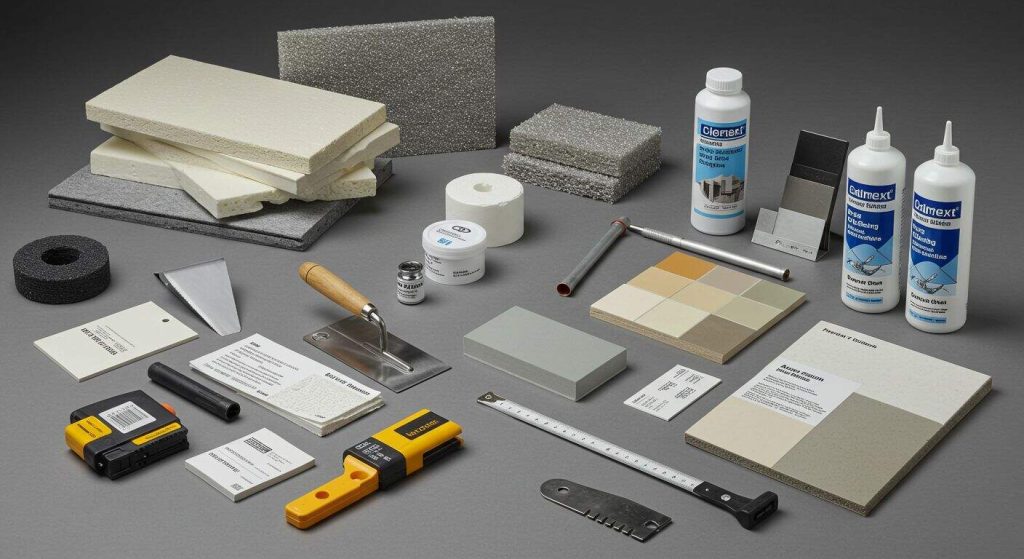
Understanding Your EIFS System Before Decorating
Before we dive into the how-to specifics, let’s talk about what you’re actually working with. EIFS is a lightweight synthetic wall cladding that includes foam plastic insulation and thin synthetic coatings. Think of it like a high-tech sandwich with multiple layers that work together to create an incredibly efficient building envelope.
The EIFS Layer System
Your EIFS system consists of these critical components:
- Substrate – Usually wood frame or masonry wall structure
- Weather barrier – Protective membrane that prevents moisture infiltration
- Insulation board – EPS foam that provides thermal performance (1-4 inches thick)
- Base coat – Protective layer with embedded reinforcing mesh
- Acrylic finish – Final decorative and weather-resistant surface
EIFS Layer System Cross-Section
Each layer serves a critical function – any penetration affects multiple systems
Each layer serves a specific purpose in the cladding system:
- Continuous insulation eliminates thermal bridging
- Weather barrier prevents moisture intrusion
- Drainage system provides a path for incidental water
- Acrylic finish protects against UV damage and weather
Why Penetrations Are Problematic
Any penetration through this carefully engineered system can compromise multiple functions:
Thermal Performance Issues:
- Breaks in continuous insulation create cold spots
- Thermal bridging reduces energy efficiency
- Increased heating and cooling costs
Moisture Management Problems:
- Water can enter through penetration points
- EPS foam can retain moisture and lose R-value
- Frame rot can occur behind the system
- Mold growth in wall cavities
Structural Integrity Concerns:
- Base coat and reinforcing mesh can delaminate
- Acrylic finish may crack around penetrations
- Expansion joints can be compromised
Types of EIFS and Their Decoration Considerations
Not all EIFS systems are created equal. Understanding which type you have is crucial for safe decoration planning:
Barrier EIFS Systems
Characteristics:
- Installed primarily before mid-1990s
- Relies entirely on outer finish for water protection
- No drainage cavity behind insulation
- More sensitive to penetrations
Decoration Considerations:
- Extremely cautious approach required
- Any penetration risks water infiltration
- Professional consultation recommended for permanent fixtures
- Regular inspection critical after any work
Water-Managed EIFS (EIFS with Drainage)
Features:
- Drainage cavity behind insulation board
- Intended to provide a path for incidental water
- More forgiving of minor imperfections
- Better long-term moisture management
Decoration Advantages:
- Safer for carefully planned penetrations
- Better tolerance for temporary attachments
- Still requires proper techniques and materials
Identifying Your EIFS Type
Visual Clues:
- Check construction date (pre-1995 likely barrier system)
- Look for weep holes at base of walls
- Examine expansion joints for drainage features
- Review original construction documents
Professional Assessment:
- Home inspection can identify system type
- Thermal imaging reveals moisture issues
- Core samples show system construction
Safe Decoration Methods for EIFS Exteriors
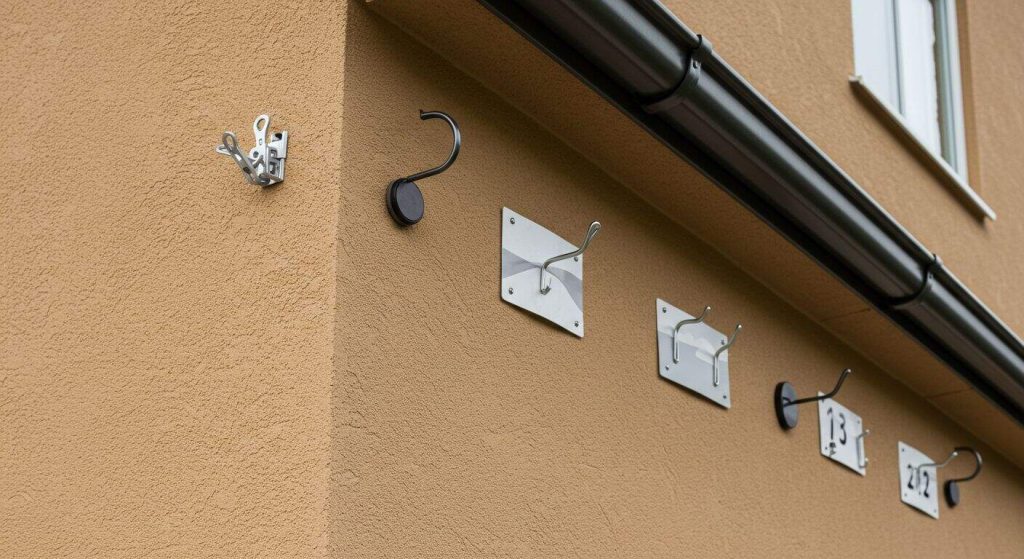
Removable Clips and Hooks: Your First Line of Defense
Removable clips are absolutely the safest way to hang outdoor lights on EIFS. These clips work by gripping edges of the finish system without penetrating the surface. If you’re dealing with any existing damage, check out our guide on EIFS repair vs full replacement to understand when professional help is needed.
Best Clip Attachment Points
Window and Door Areas:
- Trim edges provide secure attachment
- Around windows often offers stable mounting
- Door frames can support lightweight decorations
- Avoid blocking drainage paths
Roof and Eave Lines:
- Gutter systems offer magnetic attachment points
- Soffit edges can accommodate clips
- Fascia boards provide structural support
- Consider wind load factors at roof level
Foundation Transitions:
- Where EIFS meets other materials
- Often provides edge access for clips
- Lower height reduces wind load
- Easier access for installation and removal
Clip Selection Criteria
Load Capacity:
- Choose clips rated for your decoration weight
- Add 50% safety margin for wind load
- Consider dynamic loads from weather
- Distribute weight across multiple clips
Material Compatibility:
- UV resistant materials for longevity
- Soft contact surfaces to protect acrylic finish
- Corrosion-resistant for outdoor use
- Temperature-stable materials
Installation Requirements:
- No tools required for installation
- Easy removal without residue
- Adjustable positioning
- Clear attachment indicators
Magnetic Attachment Solutions
Advantages of Magnetic Hooks:
- Completely non-invasive fastener method
- No adhesive residue
- Easy repositioning
- Strong holding power with quality magnets
Best Magnetic Applications:
- Metal gutters and downspouts
- Steel door frames
- Aluminum trim pieces
- HVAC equipment housings
Magnetic Hook Selection:
- Neodymium magnets for maximum strength
- Weather-resistant coatings
- Cushioned contact surfaces
- Multiple sizes for different loads
Adhesive Solutions That Won’t Damage Your EIFS
When clips won’t work for your specific decoration needs, outdoor rated adhesive hooks offer another safe option. However, adhesive selection requires careful consideration of chemical compatibility and EIFS system characteristics.
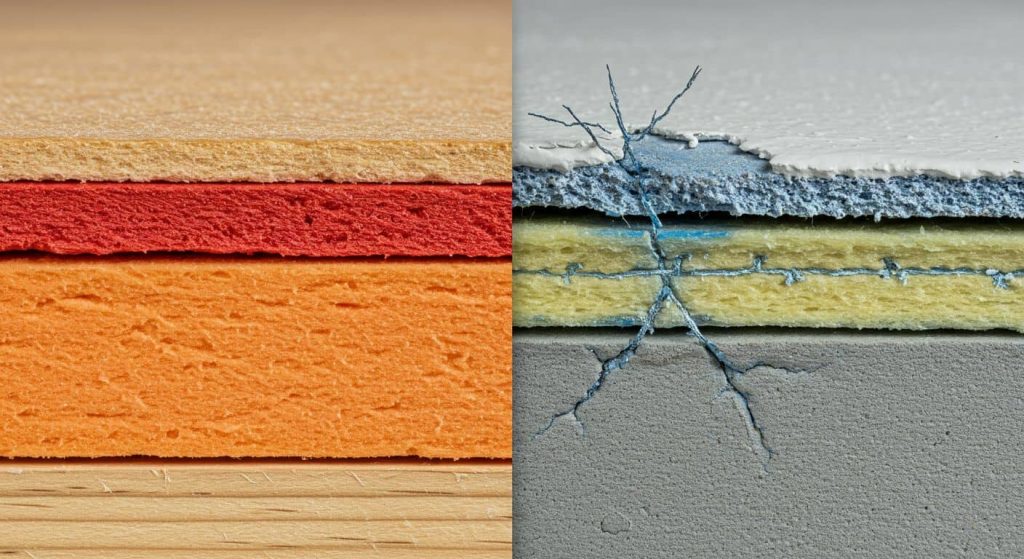
Understanding EIFS Surface Chemistry
Acrylic Finish Properties:
- Textured surface affects adhesive contact
- UV stabilizers can interfere with bonding
- Surface temperature affects adhesive performance
- Moisture management considerations
Thermal Movement:
- EIFS expands and contracts significantly
- Daily temperature cycles stress adhesive bonds
- Seasonal movement requires flexible adhesives
- Expansion joints accommodate major movement
Recommended Adhesive Types
Outdoor Command Strips:
- Designed for exterior temperature ranges
- Removable without adhesive residue
- Weight bearing limits clearly marked
- Multiple sizes available
Professional-Grade Adhesives:
- Sealant compatibility tested
- Extended temperature performance
- UV resistant formulations
- Designed for textured surfaces
Specialty EIFS Adhesives:
- Formulated specifically for synthetic stucco
- Account for thermal expansion
- Compatible with acrylic finish chemistry
- Available through EIFS contractors
Adhesive Installation Best Practices
Surface Preparation:
- Clean with soft wash methods
- Allow surface to dry completely
- Check surface temperature (50-90°F ideal)
- Avoid installation in direct sunlight
Application Technique:
- Follow manufacturer instructions exactly
- Apply even pressure during installation
- Allow full cure time before loading
- Test bond strength before full decoration
Load Considerations:
- Never exceed manufacturer weight limits
- Account for wind load multipliers
- Distribute loads across multiple attachment points
- Consider decoration movement in wind
Weight Limits and Load Distribution
This is where I see homeowners get into trouble most often. EIFS provides excellent insulation and weather protection, but it’s not designed to support heavy hanging loads like traditional masonry or wood frame systems.
Understanding EIFS Load Capacity
Typical Load Limits:
- 5-10 pounds per square foot for distributed loads
- 2-5 pounds maximum for concentrated point loads
- Shear strength varies with system age and condition
- Professional evaluation needed for heavier items
Factors Affecting Load Capacity:
- EIFS system type and age
- Base coat and reinforcing mesh condition
- EPS foam density and thickness
- Installation quality and substrate condition
Load Distribution Strategies
Multiple Attachment Points:
- Spread weight across several clips or hooks
- Use horizontal spreader bars for linear loads
- Consider cable systems for long light strings
- Avoid single-point suspension
Load Path Analysis:
- Understand how forces transfer through EIFS system
- Consider both vertical and lateral loads
- Account for wind load amplification
- Plan for worst-case loading scenarios
Common Decoration Weights
Lighting Systems:
- UL listed light strings: 0.5-1 lb per 100 feet
- LED strip lighting: 0.2-0.5 lb per 100 feet
- Rope lights: 1-2 lbs per 100 feet
- Outdoor extension cords: 2-4 lbs per 100 feet
Decorative Elements:
- Fabric banners: 1-3 lbs per square foot
- Artificial greenery: 2-5 lbs per linear foot
- Small flags: 0.5-2 lbs each
- House numbers: 1-3 lbs per digit
Seasonal Decorations:
- Wreaths: 2-8 lbs each
- Seasonal decor items: 1-5 lbs typically
- Inflatable decorations: Consider wind load primarily
- Planters: Include soil and water weight
EIFS Weight Capacity Guidelines
| Decoration Type | Typical Weight | Safe Load Limit | Attachment Method |
|---|---|---|---|
| LED Light Strings (100 ft) | 0.5-1 lb | ✅ Safe | Clips/Hooks |
| Small Wreaths | 2-5 lbs | ⚠️ Caution | Multiple Hooks |
| House Numbers | 1-3 lbs each | ✅ Safe | Professional Install |
| Large Decorations | 8+ lbs | ❌ Avoid | Landscape Mount |
| Fabric Banners | 1-3 lb/sq ft | ⚠️ Consider Wind | Edge Clips |
⚠️ Always add 50% safety margin for wind loads and dynamic forces!
What Never to Do: Avoiding EIFS Damage
The Nail and Screw Prohibition
I cannot stress this enough: never use nails or invasive anchors into EIFS. Here’s why this is such a critical issue:
Immediate Damage:
- Hairline cracks around penetration points
- Acrylic finish damage and discoloration
- Base coat and reinforcing mesh disruption
- Potential EPS foam compression
Long-Term Consequences:
- Moisture intrusion through penetration holes
- EPS foam deterioration and R-value loss
- Frame rot behind the system
- Mold growth in wall cavities
- Complete system failure requiring replacement
Safe vs. Unsafe EIFS Decoration Methods
✅ SAFE METHODS
- 🔗 Removable clips on edges
- 🧲 Magnetic hooks on metal trim
- 📎 Outdoor adhesive hooks
- 🏠 Landscape integration
- 💡 Projection lighting
❌ UNSAFE METHODS
- 🔨 Nails into EIFS surface
- 🔩 Screws through finish
- ⚡ Staples or tacks
- 🧪 Harsh chemical solvents
- 💧 High-pressure washing
💡 Remember: Safe methods preserve your EIFS warranty and prevent costly repairs!
For more details on identifying early problems, read our article on 5 warning signs your EIFS needs repair now.
Chemical Damage Prevention
Harmful Cleaning Products:
- Petroleum-based solvents
- Strong acids or alkalis
- Abrasive cleaners
- Power washing at high pressure
Safe Cleaning Methods:
- Soft wash cleaning with mild detergents
- Low-pressure water rinse
- Soft-bristle brushes for stubborn dirt
- Professional EIFS system cleaning products
Temperature-Related Damage
Hot Weather Risks:
- Surface temperature above 140°F can soften adhesives
- Thermal expansion can stress attachment points
- UV exposure degrades some materials rapidly
- Heat buildup behind dark decorations
Cold Weather Concerns:
- EIFS becomes brittle below 40°F
- Adhesives may not bond properly
- Ice dam prevention important for roof attachments
- Thermal contraction stresses connections
Professional Installation Techniques for Permanent Fixtures
Sometimes you need permanent outdoor fixtures like house numbers, flag holders, or architectural elements. Here’s how we handle these professionally without compromising your EIFS system:
When Professional Installation Is Required
Complex Penetrations:
- Electrical fixtures requiring wiring
- Heavy decorative elements
- Multi-story installations
- Structural integrity concerns
Code Compliance Issues:
- Building code requirements
- Energy code compliance
- Electrical safety standards
- OSHA compliance for commercial work
Proper Penetration Techniques
Pre-Installation Assessment:
- Locate expansion joints and avoid bridging
- Identify drainage paths and maintain function
- Check for existing moisture issues
- Verify substrate condition and capacity
Penetration Best Practices:
- Precise hole cutting with appropriate tools
- Proper flashing details around all penetrations
- Breathable sealant application
- Color match caulk for aesthetic integrity
Sealing and Weatherproofing:
- Flashing tape installation
- Multiple layers of weather protection
- Sealant compatibility with EIFS materials
- Long-term monitoring and maintenance plan
Working with Expansion Joints
Expansion joints are crucial for long-lasting EIFS stucco finishes. These joints allow the system to move with temperature changes without cracking. Learn more about this critical component in our detailed guide on expansion joints for EIFS stucco finishes.
Joint Function and Importance:
- Accommodate thermal movement
- Prevent stress concentration
- Maintain weather barrier integrity
- Allow for building settlement
Decoration Considerations:
- Never bridge joints with rigid decorations
- Plan flexible connections across joints
- Respect joint spacing and function
- Monitor for joint movement during installation
Seasonal Considerations for EIFS Decoration
Spring and Summer Decoration Planning
Warm Weather Advantages:
- Optimal adhesive bonding conditions
- Surface temperature in ideal range
- Extended daylight for installation
- Better weather for ladder work
Summer Challenges:
- High surface temperatures can affect adhesives
- Rapid thermal cycling stresses connections
- UV exposure intensifies
- Wind load from summer storms
Fall and Winter Considerations
Cool Weather Benefits:
- Reduced thermal stress on attachments
- Lower UV exposure
- Stable atmospheric conditions
- Extended decoration display periods
Cold Weather Challenges:
- EIFS becomes more brittle
- Adhesive performance may decrease
- Ice dam prevention concerns
- Limited installation windows
Year-Round Decoration Strategies
Permanent Installations:
- Plan for full seasonal temperature range
- Use materials rated for -20°F to 150°F
- Design for thermal movement
- Include maintenance access
Temporary Decorations:
- Match installation season to decoration type
- Plan removal before extreme weather
- Use appropriate materials for season
- Monitor performance during weather changes
EIFS Decoration Performance by Temperature
❄️ Cold Weather (Below 40°F)
- • EIFS becomes brittle
- • Adhesives may fail
- • Use flexible materials
- • Avoid installation
🌡️ Optimal (50-90°F)
- • Best adhesive bonding
- • EIFS most flexible
- • Ideal installation time
- • Longest decoration life
🌡️ Hot Weather (Above 100°F)
- • Surface too hot for adhesives
- • Thermal expansion stress
- • UV damage accelerated
- • Install in shade/evening
Maintenance and Care During Decorating Season
Regular Inspection Schedule
Weekly Checks During Active Use:
- Verify all attachment points remain secure
- Look for hairline cracks around connections
- Check for signs of moisture intrusion
- Monitor decoration condition and stability
Our spring EIFS checklist provides detailed inspection guidance that applies year-round.
Monthly Comprehensive Review:
- Document any changes in EIFS condition
- Check expansion joint movement
- Verify drainage system function
- Update maintenance records
Post-Installation Cleanup
Immediate Post-Installation:
- Remove all adhesive residue safely
- Clean EIFS surface with approved methods
- Inspect for any installation damage
- Apply touch-up finish if needed
Documentation and Records:
- Photograph installation and removal
- Record attachment methods used
- Note any EIFS condition changes
- Schedule follow-up inspections
📋 EIFS Decoration Safety Checklist
📅 Weekly Checks
- ☐ Verify clip security
- ☐ Check for cracks
- ☐ Inspect adhesive bonds
- ☐ Look for moisture signs
- ☐ Test decoration stability
📆 Monthly Reviews
- ☐ Document EIFS condition
- ☐ Check expansion joints
- ☐ Verify drainage function
- ☐ Update maintenance records
- ☐ Plan seasonal changes
🔧 Post-Installation
- ☐ Remove adhesive residue
- ☐ Clean EIFS surface
- ☐ Inspect for damage
- ☐ Apply touch-up finish
- ☐ Schedule follow-up
🏠 Regular inspection prevents small issues from becoming expensive repairs!
Professional Services and When to Call for Help
Recognizing DIY Limitations
Safety Concerns:
- Ladder safety on multi-story homes
- Electrical work near EIFS
- Heavy decoration installation
- Complex attachment requirements
Technical Challenges:
- Unknown EIFS system type
- Existing moisture damage
- Building code compliance
- Manufacturer warranty preservation
The Value of Professional EIFS Contractors

As an EIFS contractor with 160 years of combined team experience, I’ve seen the difference proper technique makes. Professional installation ensures:
Technical Expertise:
- Proper EIFS system identification
- Appropriate attachment method selection
- Chemical compatibility verification
- Weather barrier integrity maintenance
Code and Warranty Compliance:
- Building code requirement adherence
- Manufacturer warranty preservation
- Energy code compliance maintenance
- Professional liability coverage
Professional EIFS installation contractors carry insurance and training that covers safe high-access work. If you’re considering any major exterior changes, our comprehensive EIFS installation guide for first-time homebuilders covers important safety and technical considerations.
Troubleshooting Common Decoration Problems
Adhesive Failure Diagnosis
Common Failure Modes:
- Temperature cycling fatigue
- Chemical compatibility issues
- Improper surface prep
- Exceeded weight limits
Failure Prevention:
- Choose appropriate adhesive type
- Follow installation procedures exactly
- Monitor loading conditions
- Plan for environmental stresses
Wind Damage Prevention
Understanding Wind Loads:
- Decorations act as sails in wind
- Wind load increases with height
- Corner and edge locations experience higher forces
- Gusting creates dynamic loading
Mitigation Strategies:
- Use multiple smaller decorations instead of large ones
- Plan breakaway connections for extreme weather
- Remove decorations during severe weather warnings
- Design for 90+ mph wind survival
Managing Thermal Movement
Movement Accommodation:
- Use flexible connections where possible
- Allow for expansion and contraction
- Avoid rigid spans across expansion joints
- Monitor connections after temperature changes
Material Selection:
- Choose materials with similar expansion rates
- Use flexible sealants and adhesives
- Design connections for movement
- Plan maintenance for thermal stress points
Advanced Decoration Techniques for EIFS Homes
Creative Non-Invasive Solutions
Projection Lighting Systems:
- No physical attachments required
- Infinite design possibilities
- Easy seasonal changes
- Energy efficiency through LED technology
Landscape Integration:
- Freestanding poles for banners and flags
- Garden stakes for pathway lighting
- Temporary planters supporting decorative elements
- Separate structures for heavy decorations
Technology Integration
Smart Home Compatibility:
- Low-voltage LED systems
- Wireless control capabilities
- Solar-powered options
- Battery-operated decorations
Modern Materials:
- UV resistant LED strips
- Flexible adhesive-backed lighting
- Smart color-changing systems
- Weather-resistant controllers
Architectural Enhancement
Working with EIFS Design:
- Emphasize clean lines and smooth surfaces
- Use lighting to highlight architectural features
- Complement acrylic finish colors
- Respect building proportions
Custom Installation Options:
- EPS foam shaping during installation
- Integrated mounting systems
- Hidden wiring pathways
- Designed-in decoration points
Cost Considerations and Long-Term Value
Prevention vs. Repair Economics
Safe Decoration Investment:
- Quality clips and adhesives: $50-200
- Professional consultation: $150-300
- Proper materials and tools: $100-500
- Total safe decoration setup: $300-1,000
EIFS Repair Costs:
- Minor moisture damage repair: $1,000-3,000
- Base coat and reinforcing mesh replacement: $3,000-8,000
- Insulation board replacement: $5,000-15,000
- Complete system replacement: $15,000-40,000+
Prevention vs. Repair Cost Analysis
💰 ROI: Investing $1,000 in safe decoration methods can prevent $20,000+ in repairs!
Insurance and Warranty Implications
Warranty Considerations:
- Improper penetrations void manufacturer warranty
- EIFS contractors exclude damage from improper modifications
- Documentation required for warranty claims
- Professional installation preserves coverage
Insurance Coverage:
- Damage from improper maintenance may not be covered
- Professional installation provides liability protection
- Proper documentation supports claims
- Preventive measures reduce risk
Building Code Compliance and Safety Regulations
Indiana Building Code Requirements
General Provisions:
- EIFS systems must maintain energy efficiency
- Electrical installations require permits
- Structural integrity cannot be compromised
- Professional installation required for some applications
Specific Restrictions:
- Penetration limitations in some municipalities
- Fire safety requirements for lighting
- Wind load calculations for large decorations
- Accessibility requirements for maintenance
Safety Standards Compliance
Electrical Safety:
- UL listed components required
- Ground fault circuit interrupter (GFCI) protection
- Waterproof connectors for outdoor use
- Professional installation for permanent wiring
Structural Safety:
- Load calculations for heavy decorations
- Wind load analysis for exposed installations
- Ladder safety protocols
- Fall protection requirements
Environmental Considerations and Sustainability
EIFS and Environmental Performance
Energy Efficiency Benefits:
- Continuous insulation reduces energy consumption
- Proper decoration preserves thermal performance
- UV resistant materials extend system life
- Solar integration possibilities
Sustainable Decoration Practices:
- Choose durable, long-lasting materials
- Plan for reuse and recycling
- Minimize environmental impact
- Consider solar-powered options
Weather Resistance Planning
Indiana Climate Challenges:
- Temperature range: -10°F to 100°F
- High humidity and precipitation
- Severe thunderstorms and wind loads
- UV exposure and thermal cycling
Material Selection Criteria:
- UV resistant formulations
- Temperature stability across full range
- Moisture resistance
- Corrosion protection
Future-Proofing Your EIFS Decoration Strategy
Emerging Technologies
Smart Materials:
- Self-healing adhesives
- Shape-memory alloys for connections
- Smart materials that respond to temperature
- IoT integration for monitoring
Advanced Lighting:
- Organic LED (OLED) flexible panels
- Quantum dot technology
- Enhanced energy efficiency
- Longer service life
Long-Term Maintenance Planning
Documentation Systems:
- Digital records of all installations
- Photo documentation of conditions
- Performance monitoring data
- Maintenance scheduling systems
System Evolution:
- Plan for decoration upgrades
- Anticipate technology changes
- Design for easy modification
- Consider future accessibility needs
Manufacturer Developments
EIFS Technology Advances:
- Improved drainage systems
- Enhanced acrylic finish formulations
- Better adhesive compatibility
- Integrated decoration systems
Industry Standards Evolution:
- Updated installation guidelines
- New testing protocols
- Enhanced performance requirements
- Improved chemical compatibility data
Conclusion: Enjoying Your EIFS Home Safely
Your EIFS home can be beautifully decorated for any season or occasion. The key is understanding that EIFS requires different approaches than traditional exterior cladding systems. With 22 years of working with EIFS, I’ve learned that homeowners who enjoy their systems the most are those who respect what makes EIFS special: its energy efficiency, weather resistance, and design flexibility.
Key Success Factors
Respect System Limitations:
- Understand weight bearing capacities
- Work with thermal movement
- Preserve moisture management function
- Maintain structural integrity
Choose Appropriate Methods:
- Use non-invasive fastener techniques
- Select compatible materials
- Plan for environmental conditions
- Consider long-term performance
Invest in Quality:
- Choose professional-grade materials
- Invest in proper installation
- Plan for maintenance and monitoring
- Document all work performed
Professional Resources
When in doubt, consult with professional EIFS contractors who understand both technical requirements and aesthetic possibilities. EIFS offers unique opportunities for creative decoration – you just need to work with the system, not against it.
Want to ensure your decorating plans won’t damage your EIFS? Call Indiana Wall Systems at (765) 341-6020 for a free consultation. We’ll help you create beautiful displays that protect your home’s performance and value. You can also learn more about our EIFS repair services and explore our complete range of exterior solutions.
FAQs
Can I hang outdoor lights on my EIFS home without damaging it?
Yes, you can safely hang outdoor lights on EIFS using removable clips, magnetic hooks, or outdoor rated adhesive hooks. The key is never using nails, screws, or other invasive fasteners that penetrate the acrylic finish. Focus on attachment points like window trim edges, gutters, and areas where EIFS meets other materials. Always respect weight bearing limits and distribute loads across multiple attachment points to prevent damage to your EIFS system.
What’s the maximum weight I can safely hang on EIFS?
Most residential EIFS installation can safely support 5-10 pounds per square foot for distributed loads, but only 2-5 pounds for concentrated point loads. For example, UL listed light strings weighing less than 1 pound per 100 feet are typically safe, but heavy wreaths or large decorations should be avoided or supported through landscape mounting. Always add a 50% safety margin for wind load considerations, especially in Indiana’s variable weather conditions.
Will adhesive hooks damage my EIFS finish when removed?
High-quality outdoor rated adhesive hooks designed for textured surfaces can be safely removed from EIFS without damage when used properly. Choose products specifically rated for temperature fluctuations and follow manufacturer instructions for installation and removal. Test in an inconspicuous area first to verify chemical compatibility with your acrylic finish. Avoid petroleum-based adhesives and always remove decorations during extreme weather to prevent adhesive failure that could damage the surface.
How do I know if my EIFS system can handle decorations?
The safest approach is to have a professional EIFS contractor assess your system’s condition and type. Barrier EIFS systems (typically pre-1995) are more sensitive to any modifications, while newer water-managed EIFS with drainage capabilities are more forgiving. Look for signs like hairline cracks, soft spots, or moisture intrusion that indicate existing problems. Regular inspections help identify issues before they become expensive repairs that could affect your decoration plans.
What should I do if I accidentally damage my EIFS while decorating?
Stop immediately and assess the damage. Small hairline cracks or minor acrylic finish damage should be addressed quickly to prevent moisture intrusion. Contact a professional EIFS contractor for proper repair using color match caulk and appropriate touch-up finish materials. Document the damage with photos for insurance purposes and avoid DIY repairs that could void your manufacturer warranty. Quick professional attention can prevent minor damage from becoming a major structural integrity issue.
About the Author: Jeff Johnson is the CEO of Indiana Wall Systems, with over 22 years of experience in EIFS installation, repair, and maintenance. His team serves homeowners and commercial property owners throughout central Indiana, providing expert guidance on all aspects of EIFS system care and enhancement.

